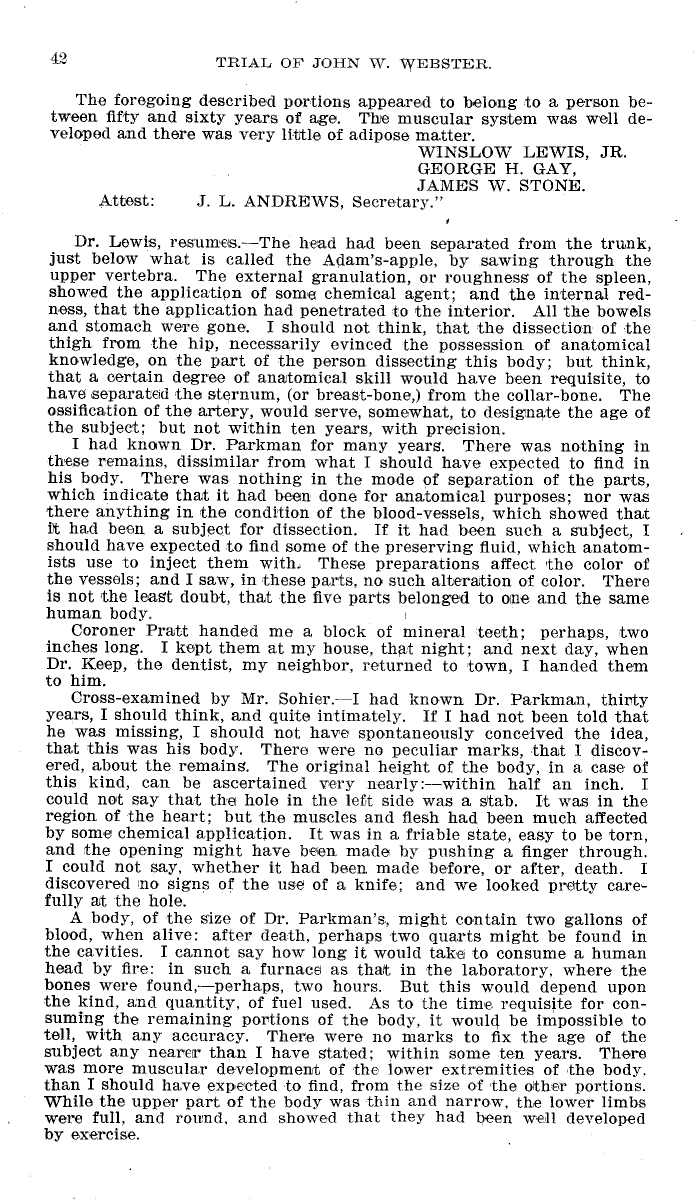|
42 TRIAL OF JOHN W. WEBSTER.
The foregoing described portions appeared to belong to a person be-
tween fifty and sixty years of age. The muscular system was well de-
veloped and there was very little of adipose matter.
WINSLOW LEWIS, JR.
GEORGE H. GAY,
JAMES W. STONE.
Attest: J. L. ANDREWS, Secretary."
Dr. Lewis, resumes.--The head had been separated from the trunk,
just below what is called the Adam's-apple, by sawing through the
upper vertebra. The external granulation, or roughness of the spleen,
showed the application of some chemical agent; and the internal red-
ness, that the application had penetrated to the interior. All the bowels
and stomach were gone. I should not think, that the dissection of the
thigh from the hip, necessarily evinced the possession of anatomical
knowledge, on the part of the person dissecting this body; but think,
that a certain degree of anatomical skill would have been requisite, to
have separated the sternum, (or breast-bone,) from the collar-bone. The
ossification of the artery, would serve, somewhat, to designate the age of
the subject; but not within ten years, with precision.
I had known Dr. Parkman for many years. There was nothing in
these remains, dissimilar from what I should have expected to find in
his body. There was nothing in the mode of separation of the parts,
which indicate that it had been done for anatomical purposes; nor was
there anything in the condition of the blood-vessels, which showed that
it had been a subject for dissection. If it had been such a subject, I
should have expected to find some of the preserving fluid, which anatom-
ists use to inject them with. These preparations affect the color of
the vessels; and I saw, in these parts, no such alteration of color. There
is not the least doubt, that the five parts belonged to one and the same
human body,
Coroner Pratt handed me a block of mineral teeth; perhaps, two
inches long. I kept them at my house, that night; and next day, when
Dr. Keep, the dentist, my neighbor, returned to town, I handed them
to him.
Cross-examined by Mr. Sohier.--I had known Dr. Parkman, thirty
years, I should think, and quite intimately. If I had not been told that
he was missing, I should not have spontaneously conceived the idea,
that this was his body. There were no peculiar marks, that I discov-
ered, about the remains. The original height of the body, in a case- of
this kind, can be ascertained very nearly:--within half an inch. I
could not say that the hole in the left side was a stab. It was in the
region of the heart; but the muscles and flesh had been much affected
by some chemical application. It was in a friable state, easy to be torn,
and :the opening might have been made by pushing a finger through.
I could not say, whether it had been made before, or after, death. I
discovered no signs of the use of a knife; and we looked pratty care-
fully at the hole.
A body, of the size of Dr. Parkman's, might contain two gallons of
blood, when alive: after death, perhaps two quarts might be found in
the cavities. I cannot say how long it would take to consume a human
head by fire: in such a furnace as that in the laboratory, where the
bones were found,-perhaps, two hours. But this would depend upon
the kind, and quantity, of fuel used. As to the time. requisite for con-
suming the remaining portions of the body, it would be impossible to
tell, with any accuracy. There were no marks to fix the age of the
subject any nearer than I have stated; within some ten years. There
was more muscular development of the lower extremities of the body.
than I should have expected to find, from the size of the other portions.
While the upper part of the body was thin and narrow, the lower limbs
were full, and round, and showed that they had been well developed
by exercise.
|

